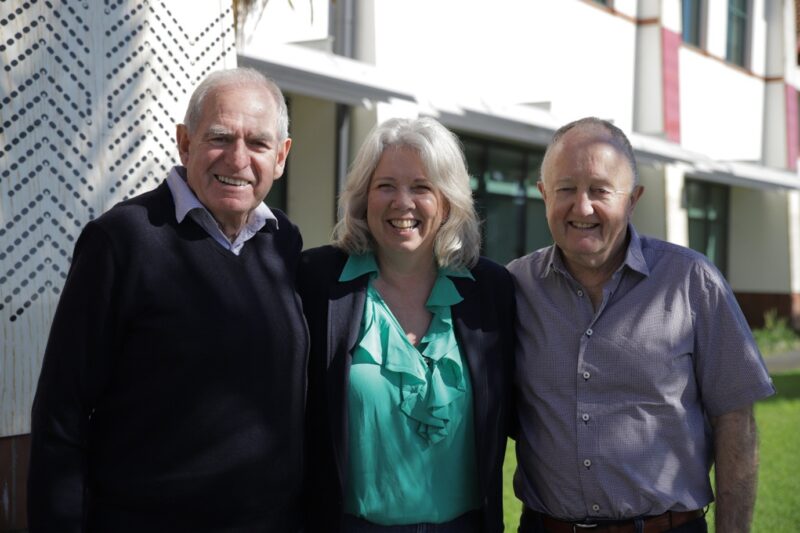
(L-R) Graeme McClennan, Gaynor Matthews and Gil Laurenson
The story of getting our trades academy up and going is one of schools and MIT working together with industry to ensure local young people have a strong pathway from secondary education to the workforce.
It is impossible to tell without mentioning a trio known as the 3Gs: Graeme McClennan, Gil Laurenson and Gaynor Matthews.
To celebrate the academy’s tenth anniversary, they got together to talk to MITNET about the early days of realising the vision, which has started careers for hundreds in our community.
“I remember being called down for a meeting in the bosses’ area,” says ‘G1’ Graeme McClennan who became the first Head of Secondary-Tertiary Pathways.
“There were officials from the Ministry of Education and TEC (Tertiary Education Commission) and our own leadership team. MIT was asked whether they’d be able to put on a Trades Academy.
“There was considerable debate and I can remember taking over and saying, ‘yes, we will do that.’ I think Stuart Middleton (then Director of External Relations) and Peter Quigg (Academic Director) rounded on me afterwards and asked me, ‘how the hell are we doing to do this?’ and I said, ‘we’ll just do it.’”

Graeme McClennan and Gaynor Matthews (left) at his farewell from MIT. Gil Laurenson is in the front of frame
Prior to the decision, high schools had been operating their own academies, though the feedback received from the ministry was a model was needed to support vocational training delivery to secondary learners right across the southern part of the Auckland region.
‘G2’ Gil Laurenson was hired as the first Pathways Manager. Mr Laurenson had a long association with education in the area, as Principal of Tuakau and Otahuhu Colleges before becoming a Chief Advisor at the ministry.
“I could see the difficulty some students were having transitioning to the next stage of their lives,” Gil says. “It was a no-brainer for me.”
Despite that, the scheme didn’t meet with universal approval at first, with some principals needing to be convinced sending students to MIT wasn’t going to see their funding reduced.
While a few staff at the institute required reassuring of the merits of delivering to ‘a bunch of school students.’
Nevertheless, the academy did open in 2015 with an inaugural intake of 225 learners who were able to come to campus one-to-two days a week gaining trades skills, as they completed NCEA.
Since then that number of academy places offered each year has risen to 862 making MIT the largest tertiary-based provider of the initiative nationally.
The range of options has also broadened to include Digital Technologies, Hairdressing and Police Studies.

Gaynor Matthews with (L-R) Trades Academy learners Sose Ailepata and Keita Henry of Aorere College with their first place trophy at National Secondary Schools Culinary Challenge in 2017
The ‘third G’ Gaynor Matthews was teaching at Papakura High School when it launched and remembered the change it brought on.
“When NCEA came in it did cause a shift in achievement with the students who were ‘hands on’” Ms Matthews says.
“What was being offered didn’t meet their needs. When the partnership (with MIT) came in it raised the standards. They wanted to be the best and raise the level of achievement.
“The big thing for the students is taking the next step,” says Gaynor, who went on to become a lecturer in MIT School of Hospitality and then Head of Secondary-Tertiary Pathways.
“Exposing them while they are in school to the tertiary space. It had a really positive impact. The number achieving NCEA went up.”
Mr McClennan says it also saw 54% of academy learners make the transition to study at MIT after they’d finished school.

Emeritus Prof Stuart Middleton speaking at his farewell
The name that came up again and again in the conversation about those early years, the founding of a Centre for Multiple Pathways at MIT, School of Secondary-Tertiary Studies and also the successful introduction of the academy model to the Pacific islands was Emeritus Professor Stuart Middleton.
“Stuart was Minister for Everything in those days,” says Graeme.
“He had a Fulbright to go to Berkeley to look at disengagement in tertiary education. When he started talking to people, he decided looking at disengagement from secondary was far more important for our community.”
“He looked at engaging with NEETS (learners Not in Education, Employment or Training) and came up with the Tertiary High School concept. He was engaging with ministry officials. Youth Guarantees became a policy. All these things were knitted into the funding. It was a whole machine. Stuart was highly involved.”
As for what the next decade of the scheme will bring Gil believes more schools need to participate.
“There are schools who say, ‘we don’t have those kids.’ We know they do and there are a lot of kids still not where they want to be. We need to continue to build it and get more on board.”
For Gaynor, who has now returned to secondary teaching, this time at Pukekohe High; it’s about linking the futures of learners who wish to pursue a structured pathway to a trade while still in secondary education to the exciting new growth in southern Auckland.
While for Graeme, it’s about the change the scheme has made in the lives of each individual, whether it is through enabling them to try out a possible career or find their vocation.
“There’s a ceremony every year where we celebrate the top students. An acknowledgement of those who have done the best or tried the hardest and made a positive contribution. One of the first was at the theatre at Manukau campus. I was approached by the parents of a boy who said, ‘I want to thank you because our son is 18 and he’s been in education since he was five years old and this is the first time he’s been told he’s succeeded.
“The first time he’s been told he’s worthwhile.”
The tenth anniversary of MIT Trades Academy will be celebrated with a dinner at Dine in November.






